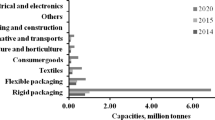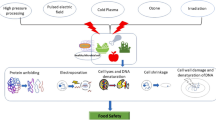Abstract
Leather is composed of a three-dimensional weave of collagen fiber bundles. Collagen is a fibrous protein well organized in the formation of skin as building blocks. Leather production involves serial operations where the tanning plays the major role in improving the durability of leather products by stabilizing the triple helical structure of collagen matrix. In the leather-making industry, different tanning agents are used to produce different kind of leather goods. These tanning agents have varied efficiency on the stabilization of collagen. In this study, thermal stability of the leathers tanned with most commonly used tanning agents was evaluated by conventional shrinking test (CST) and differential scanning calorimetry (DSC) methods. The results showed that the thermal stability of leathers varied by the type of tanning agent which were in accordance with theoretical approaches. A distinct correlation was also observed between CST and DSC results of the tanned leathers.



Similar content being viewed by others
References
Cucos A, Budrugeac P, Mitrea S, Hajdu C. The influence of sodium chloride on the melting temperature of collagen crystalline region in parchments. J Therm Anal Calorim. 2013;111:467–73.
Fathima NN, Balaraman M, Rao JR, Nair BU. Effect of zirconium(IV) complexes on the thermal and enzymatic stability of type I collagen. J Inorg Biochem. 2003;95:47–54.
Pauling L. General chemistry. New York: Dover Publications; 1988.
Kronick PL, Cooke P. Thermal stabilization of collagen fibers by calcification. Connect Tissue Res. 1996;33:275–82.
Covington AD. Quo vadit chromium? The future direction of tannage. J Am Leather Chem As. 2008;103:7–23.
Gustavson KH. The chemistry and reactivity of collagen. New York: Academic Press Inc.; 1965.
Bienkiewics K. Physical chemistry of leather making. Melbourne FL: Krieger Pub Co; 1983.
Imer S, Varnali T. Modeling chromium sulfate complexes in relation to chromium tannage in leather technology: a computational study. Appl Organomet Chem. 2000;14:660–9.
Covington AD. Tanning chemistry, the science of leather. Northampton: The University of Northampton; 2009.
Sundarrajan A, Madhan B, Rao JR, Nair BU. Studies on tanning with zirconium oxychloride: part I standardization of tanning process. J Am Leather Chem Assoc. 2003;98:101–6.
Li Y, Shan ZH, Shao SX, Shi KQ. Reaction mechanism of tereakis hydroxymethyl phosphonium with collagen protein. J Soc Leather Technol Chem. 2006;90:214–6.
Shuangxi S, Kaiqi S, Ya L, Lan J, Chun’an M. Mechanism of chrome-free tanning with tetra-hydroxymethyl phosphonium chloride. Chin J Chem Eng. 2008;16:446–50.
Madhan B, Aravindhan R, Ranjithakumar N, Venkiah V, Rao JR, Nair BU. Combination tanning based on tara: an attempt to make chrome-free garment leather. J Am Leather Chem Assoc. 2007;102:198–204.
Tang HR, Covington AD, Hancock RA. Use of DSC to detect the heterogeneity of hydrothermal stability in the polyphenol-treated collagen matrix. J Agric Food Chem. 2003;51:6652–6.
Hui C, Zhi-Hua S. Changes in hydrothermal stability of collagen with several catechin-metal compounds: a DSC study. J Soc Leather Technol Chem. 2008;92:93–5.
Krishnamoorthy G, Sadulla S, Sehgal PK, Mandal AB. Green chemistry approaches to leather tanning process for making chrome-free leather by unnatural amino acids. J Hazard Mater. 2012;215:173–82.
Wang YJ, Guo J, Chen H, Shan ZH. Influence of containing moisture on hydrothermal stability of modified collagen thermal characteristics analysis by DSC. J Therm Anal Calorim. 2010;99:295–300.
Crudu M, Deselnicu V, Deselnicu DC, Albu L. Valorization of titanium metal wastes as tanning agent used in leather industry. Waste Manag. 2014;34:1806–14.
Carsote C, Budrugeac P, Miu L, Yalcin F, Karavana HA, Badea E. Effect of temperature and relative humidity on vegetable tanned leather studied by thermal analysis. In: ICAMS—5th international conference on advanced materials and systems; 2014. p. 505–510.
Carsote C, Badea E, Miu L, Della Gatta G. Study of the effect of tannins and animal species on the thermal stability of vegetable leather by differential scanning calorimetry. J Therm Anal Calorim. 2016;124:1255–66.
Budrugeac P. Phase transitions of a parchment manufactured from deer leather: a calorimetric and kinetic analysis. J Therm Anal Calorim. 2015;120:103–12.
Cucos A, Budrugeac P, Miu L. DMA and DSC studies of accelerated aged parchment and vegetable-tanned leather samples. Thermochim Acta. 2014;583:86–93.
Chahine C. Changes in hydrothermal stability of leather and parchment with deterioration: a DSC study. Thermochim Acta. 2000;365:101–10.
Budrugeac P, Miu L. The suitability of DSC method for damage assessment and certification of historical leathers and parchments. J Cult Herit. 2008;9:146–53.
Ershad-Langroudi A, Mirmontahai A. Thermal analysis on historical leather bookbinding treated with PEG and hydroxyapatite nanoparticles. J Therm Anal Calorim. 2015;120:1119–27.
Sebestyén Z, Czégény Z, Badea E, Carsote C, Sendrea C, Barta-Rajnai E, Bozi J, Miu L, Jaka E. Thermal characterization of new, artificially aged and historical leather and parchment. J Anal Appl Pyrolysis. 2015;115:419–27.
Cai SW, Zeng YH, Zhang WH, Wang YN, Shi B. Inverse chrome tanning technology based on wet white tanned by Al–Zr complex tanning agent. J Am Leather Chem Assoc. 2015;110:114–21.
Santos LMD, Allen SCH, Antunes APM. Optimization of enzyme-assisted phenolic reactions applied to thermal stabilization of collagen using response surface methodology. J Am Leather Chem Assoc. 2016;111:53–61.
Srivatsan KV, Lakra R, Sai KP, Kiran MS. Effect of bimetallic iron: zinc nanoparticles on collagen stabilization. J Mater Chem B. 2016;4:1437–47.
IUP 16. Leather—physical and mechanical tests—determination of shrinkage temperature up to 100 °C; 2002.
Budrugeac P, Cucos A, Miu L. The use of thermal analysis methods for authentication and conservation state determination of historical and/or cultural objects manufactured from leather. J Therm Anal Calorim. 2011;104:439–50.
Larsen R, Vest M, Nielsen K. Determination of hydrothermal stability (shrinkage temperature) of historical leather by the micro hot table technique. J Soc Leather Technol Chem. 1993;77:151–5.
Okamoto Y, Saeki K. Phase transition of collagen and gelatin. Kolloid-Zeitshrift und Zeitshrift fűr Polymere. 1964;194:124–34.
Author information
Authors and Affiliations
Corresponding author
Rights and permissions
About this article
Cite this article
Onem, E., Yorgancioglu, A., Karavana, H.A. et al. Comparison of different tanning agents on the stabilization of collagen via differential scanning calorimetry. J Therm Anal Calorim 129, 615–622 (2017). https://doi.org/10.1007/s10973-017-6175-x
Received:
Accepted:
Published:
Issue Date:
DOI: https://doi.org/10.1007/s10973-017-6175-x




